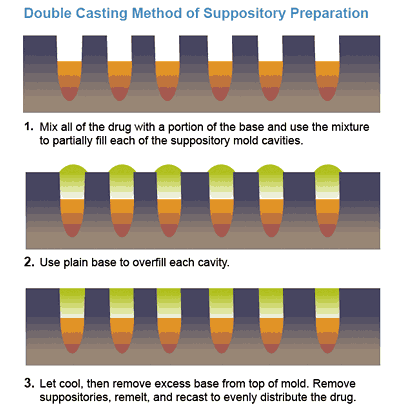Double Casting Technique
The total quantity of drug is mixed with an amount of base which is inadequate
to fill the number of cavities. The mixture is poured into the mold, partially
filling each cavity, and the remaining portion of the cavities are filled with
the melted blank base. The cooled suppositories are then removed, remelted,
mixed, and recast to evenly distribute the active ingredient. By recording the necessary information, the pharmacist can determine the weight of base displaced by the drug and then calculate the density factor.
Note: a portion of the formula will be lost during this process, so you should always prepare for 2 extra suppositories to ensure that you have enough mixture for the desired number of suppositories.


View a video demonstration on determining the density factor using the double casting technique
Sample calculation of density factor
Using a particular mold, the average weight of a plain cocoa butter suppository was found to be 2.0 g. Using the same mold, cocoa butter suppositories, each containing 300 mg of drug A, were found to weigh 2.1 g each. So,
weight of suppository of cocoa butter = 2.0 g
weight of drug in each medicated suppository = 0.3 g
weight of suppository with drug and cocoa butter = 2.1 g
weight of base in medicated suppository = 2.1 g - 0.3 g = 1.8 g
weight of base displaced = 2.0 g - 1.8 g = 0.2 g
Therefore, density factor of drug A = 0.3 g ÷ 0.2 g = 1.5
Now, knowing the density factor for the drug, the pharmacist can make calculations for a batch of suppositories. To prepare 10 suppositories:
weight of drug A needed = 10 suppositories × 300 mg/suppository =
3000 mg = 3.0 g
weight of base needed for plain suppositories = 10 suppositories ×
2.0 g/suppository = 20.0 g
weight of base displaced by 3 g drug A = 3.0 g ÷ 1.5 = 2.0 g
weight of base needed for medicated suppositories = 20.0 g - 2.0 g = 18.0
g